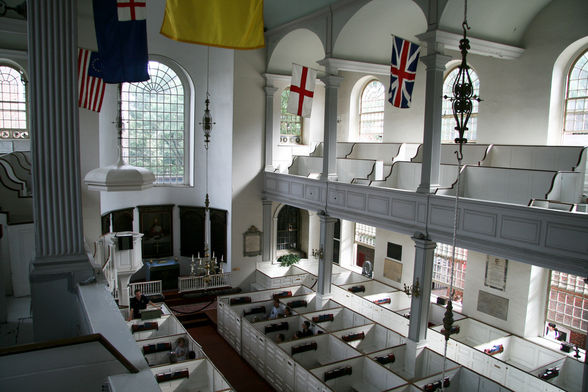
The most common question the Church Educators at The Old North Church are asked is, “what is the deal with the little boxes?’ The most common response is, “well these are box pews and each box was owned by a family. Old North was a closed congregation until 1912 and to worship here you had to own a pew.” It is at this point that most people have an outraged response. “Well that is not very Christian” they might say or “where did the people who could not afford to pay to go to Church?” All good questions but it firsts requires us to stop thinking like a 21st Century person and think like a person from the 18th century. All of history compels us to think as if we were in the particular period we are studying.
It is always good to remember that when one speaks of any topic of history, it needs to be separated from the present way society thinks about things. Religion was much different in the 17th and 18th century compared to today, and the thought process is very different.
Before the 13th century, the church did not have seats except for maybe the King and other dignitaries. The great church of Europe was built without fixed seating. If seats were required, they would be moved to the church and after the service would be removed again. Starting in the 13th century, backless stone benches began to appear in churches first along the walls and then more and more in the nave of the church.
The Protestant Reformation shifted the focus of the service from the altar of the church to the pulpit and placed more of an emphasis on the sermon. With this change came a desire to sit, perhaps the services became longer, but wooden benches started to replace the stone one during the 14th century and by the 15th century they were very common in churches.
Initially, congregants would have installed their bench at their expense then the church came to the realization that it could make money off the sale of the benches. Churches were, and are, in constant need of funds to maintain the buildings so the sales of pews would have assisted in that endeavor. As proof of ownership a pew deed was given by the church and in some instances recorded at the county deed office as an actual real estate transaction.
General seating in churches was not something that was widely available. Pew owners would be towards the front of the church while those without a pew would be situated in the back of the church. I often joke that today that would have to be reversed since no one wants to sit down front.
As the benches were not fixed to the floor at this time, the owners started to lock them in boxes so the benches would not be stolen or used by someone else if they were not in church on a particular Sunday, and this led to what can be seen at Old North today the Box Pew.
Widely used in Anglican, Roman Catholic, and Presbyterian churches, the practice started to fall out of favor around the middle of the 20th century. At Old North, the practiced ceased with the 1912 renovation although the box pews remain for historical purposes.
To those who might scoff at the idea of selling seats or the box pew system all I can say is historically speaking the practice of selling the Pew has been around much longer than the present system.
